Analysis of an Urban Grid with High Photovoltaic and e-Mobility Penetration
Abstract
1. Introduction
2. Related Work
3. Materials and Methods
3.1. Simulation Framework & Sequence
- The Consumer sends a charging request for the next simulation period (15 min)
- The Flexibility Provider maps the demand on the corresponding grid node and sends demand to the Capacity Provider.
- The Capacity Provider calculates the total grid utilization and answers with a grid fee time series.
- The Flexibility Provider communicates the Price Level to the Consumer.
- The Consumer can lock the demand to the current price level and sends a commit or reject message back.
- Corresponding to the answer, the Flexibility Provider send final demand time series to the Capacity Provider.
3.2. Agents in the Simulation Framework
3.3. Consumer Behavior
- as the start time at the destination in [HH:MM],
- as the event duration in [min],
- as the travel time to the destination and/or back in [min],
- the absence time in [min] and
- as the distance between the home and destination in [km] for a day .
- Draw the employment status and the relationship full-time or part-time. is 525 and 240 min for full- and part-time jobs.
- Determine the mobility weekday , five days are drawn for work.
- Terminate the start time depending on weekdays or weekend.
- Get the one-way distance .
- Depending on the distance, determine the travel time and the means of transport.
- Repeat step 2–5 for two hobbies with an absence time of 90 min and a certain number of errands with an absence time of 35 min per week.
- The following total price CMin at AC charging stations is low for me—I would try to charge (Stated in ct/kWh).
- The following total price CMax at AC charging stations is too high for me—I would not charge (Stated in ct/kWh).
- The following total price at AC charging stations is quite high for me—but I would charge if necessary (Stated in ct/kWh).
4. Results
4.1. Analysis of a Self-Supply-Based Charging Strategy
4.2. Analysis of More Complex Derivation of the Charging Behavior
4.3. Grid and Economic Impact Analyses
5. Conclusions
Author Contributions
Funding
Data Availability Statement
Conflicts of Interest
Nomenclature
| RES | Renewable energy sources |
| EEG | Erneuerbare-Energien-Gesetz |
| EV | Electric Vehicle |
| PV | Photovoltaic |
| PSA | Power System Analysis |
| SLP | Standard Load Profile |
| AC | Alternating Current |
| SoC | State of Charge |
| T | Set of time steps |
| t | time step |
| C | Set of EV/cars |
| c | car |
| D | [km] Travel Distance |
| [km] range of the EV | |
| [kW] maximum charging power of a car | |
| [kWh] maximum capacity of a car | |
| [kW] demand of a car at time step t | |
| [kWh] capacity level of a car at time step t | |
| [ct/kWh] dynamic grid fee at time step t | |
| S | set of segments |
| s | segment of linearized B function |
| variable to indicate the active segment | |
| lower capacity of linearized B function | |
| upper capacity of linearized B function | |
| slope of the linearized B function | |
| [kWh] sum of single | |
| [kW] power of the attached PV system at t | |
| [kW] charged power at timestep t | |
| [ct/kWh] mean price for SoC 40% | |
| [ct/kWh] upper price, charge when SoC < 20% | |
| [ct/kWh] lower price, charge when SoC < 90% |
References
- Arbeitsgruppe Energie-Monitoring. Monitoringbericht 2021; Bundesnetzagentur für Elektrizität, Gas, Telekommunikation, Post und Eisenbahnen: Berlin, Germany, 2021; p. 540. [Google Scholar]
- Statistik Kraftfahrtbundesamt. Available online: https://www.kba.de/DE/Statistik/Fahrzeuge/fahrzeuge_node.html;jsessionid=6437EAC3E3F71138982F44CD869FEFEC.live21324 (accessed on 27 October 2022).
- Elektromobilität in Deutschland. Available online: https://www.bmwk.de/Redaktion/DE/Dossier/elektromobilitaet.html415 (accessed on 3 April 2023).
- Robinson, J.; Erickson, L.E. Infrastructure for Charging Electric Vehicles. In Solar Powered Charging Infrastructure for Electric Vehicles; Erickson, L.E., Robinson, J., Brase, G., Cutsor, J., Eds.; CRC Press: Boca Raton, FL, USA, 2016; pp. 35–51. ISBN 978-1-4987-3156-0. [Google Scholar]
- Kasten, P.; Minnich, L.; Randrianarisoa, J.; Ritter, D.; Vogel, M.; Dünzen, K.; Just, L.; Novirdoust, A.A.; Diers, H.; Niesler, N.; et al. Szenarien Und Regulatorische Herausforderungen Für Den Aufbau Der Ladeinfrastruktur Für Elektrische Pkw Und Lkw. Available online: https://www.oeko.de/fileadmin/oekodoc/ENSURE-II_Ladeinfrastruktur.pdf (accessed on 3 April 2023).
- Lopes, J.A.P.; Soares, F.J.; Almeida, P.M.R. Integration of Electric Vehicles in the Electric Power System. Proc. IEEE 2011, 99, 168–183. [Google Scholar] [CrossRef]
- Green, R.C.; Wang, L.; Alam, M. The Impact of Plug-in Hybrid Electric Vehicles on Distribution Networks: A Review and Outlook. Renew. Sustain. Energy Rev. 2011, 15, 544–553. [Google Scholar] [CrossRef]
- Brinkel, N.; Alskaif, T.; van Sark, W. The Impact of Transitioning to Shared Electric Vehicles on Grid Congestion and Management. In Proceedings of the 2020 International Conference on Smart Energy Systems and Technologies (SEST), Istanbul, Turkey, 7–9 September 2020. [Google Scholar]
- Resch, M.; Buhler, J.; Schachler, B.; Sumper, A. Techno-Economic Assessment of Flexibility Options Versus Grid Expansion in Distribution Grids. IEEE Trans. Power Syst. 2021, 36, 3830–3839. [Google Scholar] [CrossRef]
- Brinkel, N.B.G.; Schram, W.L.; AlSkaif, T.A.; Lampropoulos, I.; van Sark, W.G.J.H.M. Should We Reinforce the Grid? Cost and Emission Optimization of Electric Vehicle Charging under Different Transformer Limits. Appl. Energy 2020, 276, 115285. [Google Scholar] [CrossRef]
- Zethmayr, J.; Kolata, D. Charge for Less: An Analysis of Hourly Electricity Pricing for Electric Vehicles. World Electr. Veh. J. 2019, 10, 6. [Google Scholar] [CrossRef]
- Sinha, S.; Chandel, S.S. Review of Software Tools for Hybrid Renewable Energy Systems. Renew. Sustain. Energy Rev. 2014, 32, 192–205. [Google Scholar] [CrossRef]
- Gottwalt, S. Managing Flexible Loads in Residential Areas. 2015. Available online: https://publikationen.bibliothek.kit.edu/1000048803 (accessed on 3 April 2023).
- Su, J. Smart Management of Electric Vehicles Charging in Distribution Networks. Ph.D. Thesis, Auckland University of Technology, Auckland, New Zealand, 2020. [Google Scholar]
- Babrowski, S.; Heinrichs, H.; Jochem, P.; Fichtner, W. Load Shift Potential of Electric Vehicles in Europe. J. Power Sources 2014, 255, 283–293. [Google Scholar] [CrossRef]
- Su, W.; Wang, J.; Roh, J. Stochastic Energy Scheduling in Microgrids With Intermittent Renewable Energy Resources. IEEE Trans. Smart Grid 2014, 5, 1876–1883. [Google Scholar] [CrossRef]
- Diaz-Cachinero, P.; Munoz-Hernandez, J.I.; Contreras, J. A Linear Model for Operating Microgrids with Renewable Resources, Battery Degradation Costs and Electric Vehicles. In Proceedings of the 2018 15th International Conference on the European Energy Market (EEM), Lodz, Poland, 27–29 June 2018; IEEE: Lodz, Poland, 2018; pp. 1–5. [Google Scholar]
- Soares, J.; Borges, N.; Fotouhi Ghazvini, M.A.; Vale, Z.; de Moura Oliveira, P.B. Scenario Generation for Electric Vehicles’ Uncertain Behavior in a Smart City Environment. Energy 2016, 111, 664–675. [Google Scholar] [CrossRef]
- Schäuble, J.; Kaschub, T.; Ensslen, A.; Jochem, P.; Fichtner, W. Generating Electric Vehicle Load Profiles from Empirical Data of Three EV Fleets in Southwest Germany. J. Clean. Prod. 2017, 150, 253–266. [Google Scholar] [CrossRef]
- Pflaum, P.; Alamir, M.; Lamoudi, M.Y. Probabilistic Energy Management Strategy for EV Charging Stations Using Randomized Algorithms. IEEE Trans. Contr. Syst. Technol. 2018, 26, 1099–1106. [Google Scholar] [CrossRef]
- Gerritsma, M.K.; AlSkaif, T.A.; Fidder, H.A.; Sark, W.G.J.H.M. van Flexibility of Electric Vehicle Demand: Analysis of Measured Charging Data and Simulation for the Future. WEVJ 2019, 10, 14. [Google Scholar] [CrossRef]
- Wang, B.; Zhao, D.; Dehghanian, P.; Tian, Y.; Hong, T. Aggregated Electric Vehicle Load Modeling in Large-Scale Electric Power Systems. IEEE Trans. Ind. Applicat. 2020, 56, 5796–5810. [Google Scholar] [CrossRef]
- Diaz-Cachinero, P.; Munoz-Hernandez, J.I.; Contreras, J. A Microgrid Model With EV Demand Uncertainty and Detailed Operation of Storage Systems. IEEE Trans. Ind. Applicat. 2022, 58, 2497–2511. [Google Scholar] [CrossRef]
- Xydas, E.; Marmaras, C.; Cipcigan, L.M. A Multi-Agent Based Scheduling Algorithm for Adaptive Electric Vehicles Charging. Appl. Energy 2016, 177, 354–365. [Google Scholar] [CrossRef]
- Zhang, J.; Yan, J.; Liu, Y.; Zhang, H.; Lv, G. Daily Electric Vehicle Charging Load Profiles Considering Demographics of Vehicle Users. Appl. Energy 2020, 274, 115063. [Google Scholar] [CrossRef]
- Karapidakis, E.; Tsikalakis, A.; Paspatis, A.; Fotakis, E.; Stavrakakis, G.; Chatzipoulka, C.; Zervas, P. Grid Operation Assessment under a Specific EV Chargers Deployment Plan in the City of Heraklion. Electronics 2021, 10, 2831. [Google Scholar] [CrossRef]
- Konstantinidis, G.; Karapidakis, E.; Paspatis, A. Mitigating the Impact of an Official PEV Charger Deployment Plan on an Urban Grid. Energies 2022, 15, 1321. [Google Scholar] [CrossRef]
- Paspatis, A.; Fiorentzis, K.; Katsigiannis, Y.; Karapidakis, E. Smart Campus Microgrids towards a Sustainable Energy Transition—The Case Study of the Hellenic Mediterranean University in Crete. Mathematics 2022, 10, 1065. [Google Scholar] [CrossRef]
- Pagani, M.; Korosec, W.; Chokani, N.; Abhari, R.S. User Behaviour and Electric Vehicle Charging Infrastructure: An Agent-Based Model Assessment. Appl. Energy 2019, 254, 113680. [Google Scholar] [CrossRef]
- Sundstrom, O.; Binding, C. Flexible Charging Optimization for Electric Vehicles Considering Distribution Grid Constraints. IEEE Trans. Smart Grid 2012, 3, 26–37. [Google Scholar] [CrossRef]
- Sundström, O.; Binding, C. Planning Electric-Drive Vehicle Charging under Constrained Grid Conditions. In Proceedings of the 2010 International Conference on Power System Technology, Hangzhou, China, 24–28 October 2010; pp. 1–6. [Google Scholar]
- Sun, L.; Lubkeman, D. Agent-Based Modeling of Feeder-Level Electric Vehicle Diffusion for Distribution Planning. IEEE Trans. Smart Grid 2021, 12, 751–760. [Google Scholar] [CrossRef]
- Vopava, J.; Bergmann, U.; Kienberger, T. Synergies between E-Mobility and Photovoltaic Potentials—A Case Study on an Urban Medium Voltage Grid. Energies 2020, 13, 3795. [Google Scholar] [CrossRef]
- Tsiakis, P.; Shah, N.; Pantelides, C.C. Design of Multi-Echelon Supply Chain Networks under Demand Uncertainty. Ind. Eng. Chem. Res. 2001, 40, 3585–3604. [Google Scholar] [CrossRef]
- Brown, T.; Hörsch, J.; Schlachtberger, D. PyPSA: Python for Power System Analysis. JORS 2018, 6, 4. [Google Scholar] [CrossRef]
- infas, DLR, IVT und infas 360 Mobilität in Deutschland (on behalf of BMVI). 2018. Available online: https://www.mobilitaet-in-deutschland.de/archive/pdf/MiD2017_Ergebnisbericht.pdf (accessed on 10 April 2023).
- Standardlastprofile-Strom. Available online: https://www.bdew.de/energie/standardlastprofile-strom/ (accessed on 27 October 2022).
- Jazaeri, J.; Gordon, R.L.; Alpcan, T. Influence of Building Envelopes, Climates, and Occupancy Patterns on Residential HVAC Demand. J. Build. Eng. 2019, 22, 33–47. [Google Scholar] [CrossRef]
- Solarkataster. Available online: https://www.energiedaten.nrw.de (accessed on 27 October 2022).
- Muñoz Sabater, J. ERA5-Land Hourly Data from 1950 to Present. Copernicus Climate Change Service (C3S) Climate Data Store (CDS). 2019. Available online: https://cds.climate.copernicus.eu/cdsapp#!/dataset/10.24381/cds.e2161bac?tab=overview (accessed on 10 April 2023).
- Holmgren, F.; Hansen, W.; Mikofski, A. Pvlib Python: A Python Package for Modeling Solar Energy Systems. JOSS 2018, 3, 884. [Google Scholar] [CrossRef]
- Frank, D.; Kleis, K.; Dr., Schmid, E.; Schrader, T.-S.; Schwarze, E. Hendrik Zimmermann Effektive Stromnetzentgelte Für Die Transformation. Available online: https://www.germanwatch.org/de/85071 (accessed on 3 April 2023).
- Georg, J.H. “Smartes“ Laden an Öffentlichen Ladesäulen: Anreizmodell Für Markt- Und Netzdienliches Laden, Energiewirtschaftliche Tagesfragen 72. 2022. Available online: http://www.jhc-energie.de/.cm4all/uproc.php/0/et-Artikel-29072022-PDF_18115_et_7-8_2022_S.37-41.pdf (accessed on 3 April 2023).


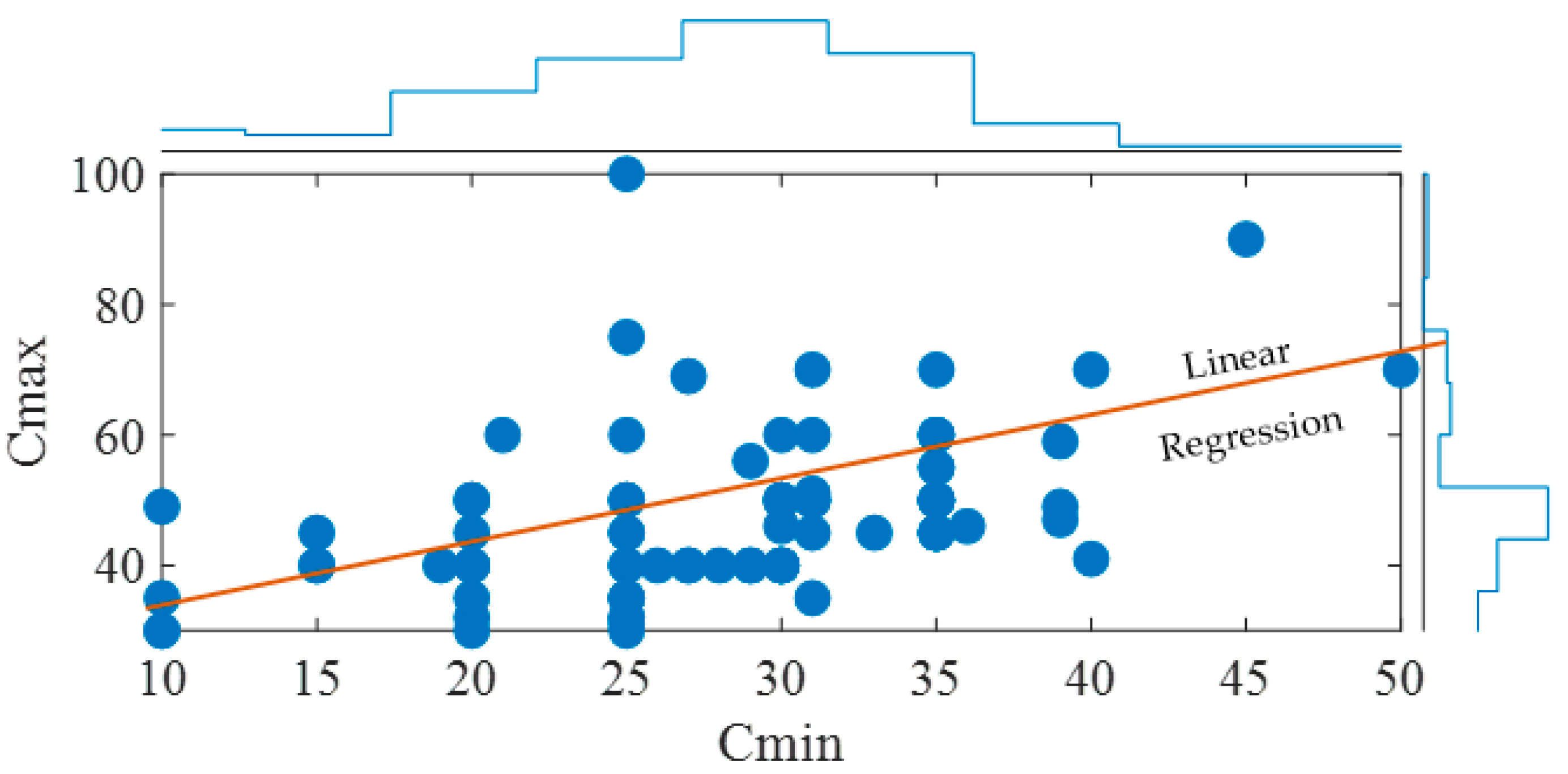
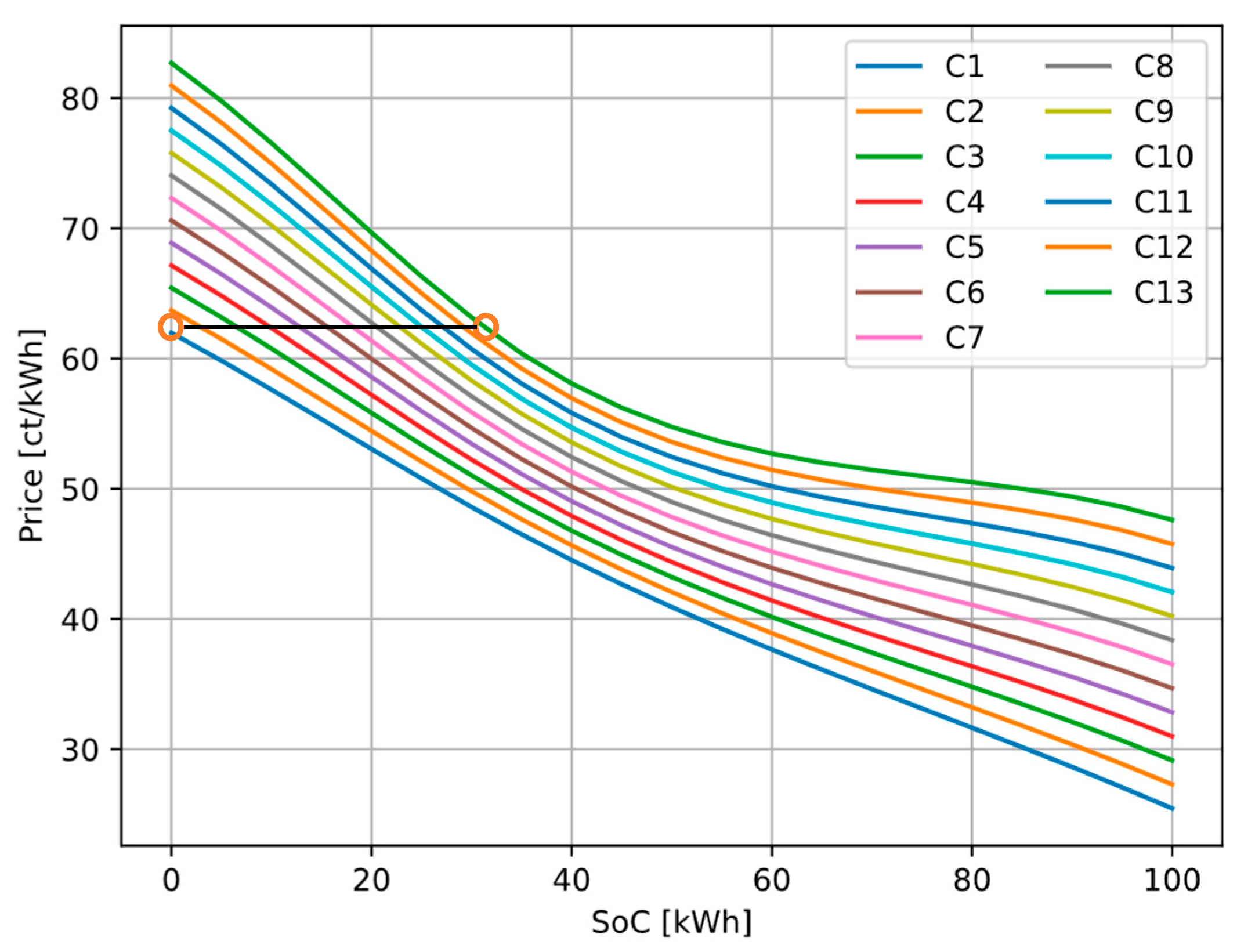
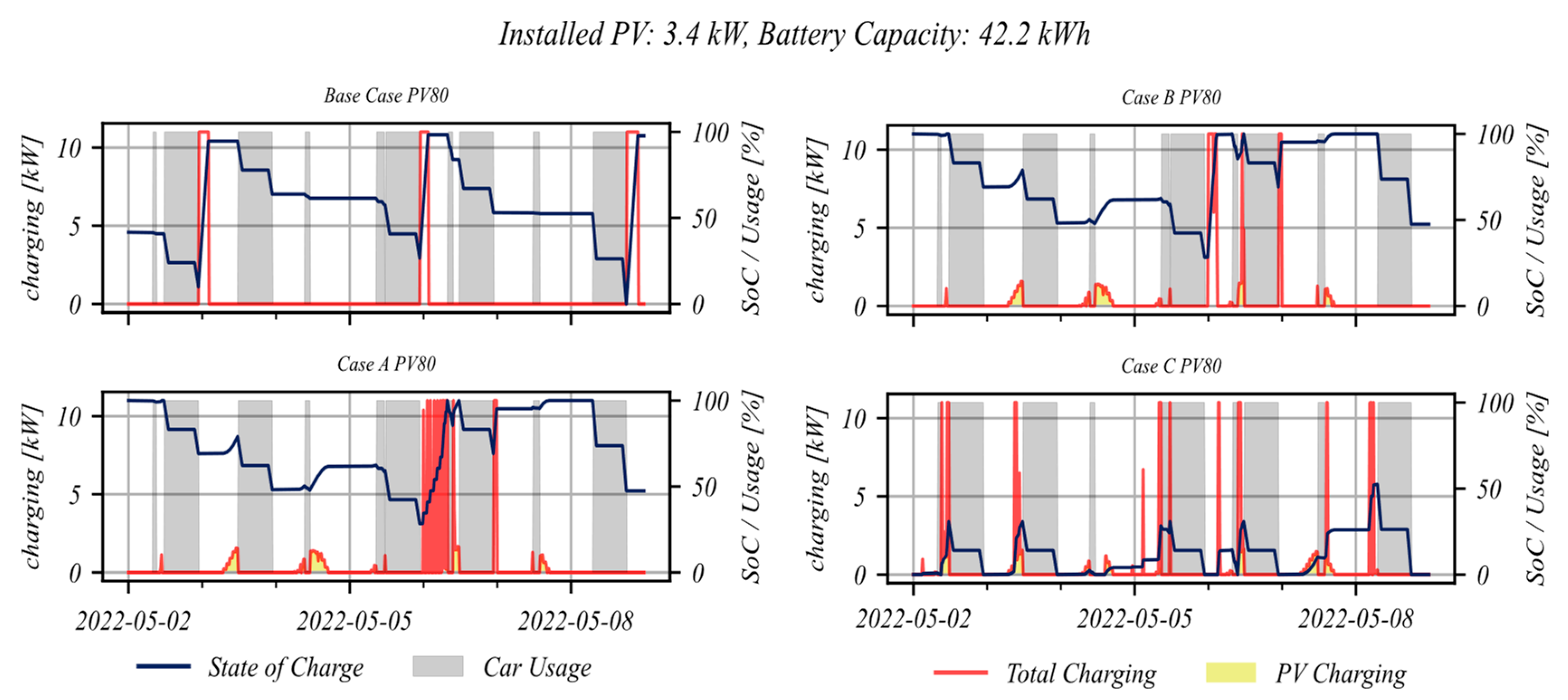
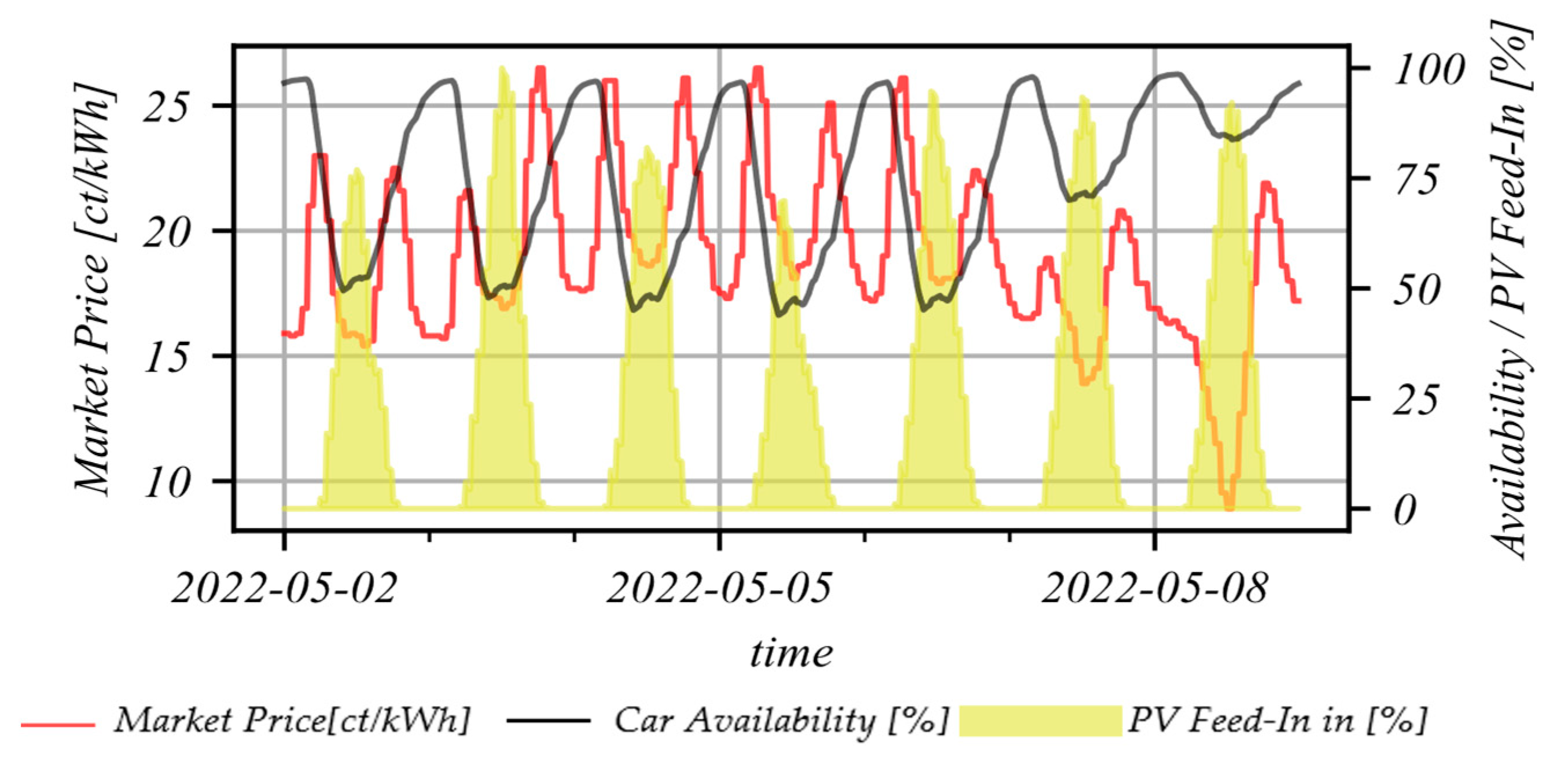
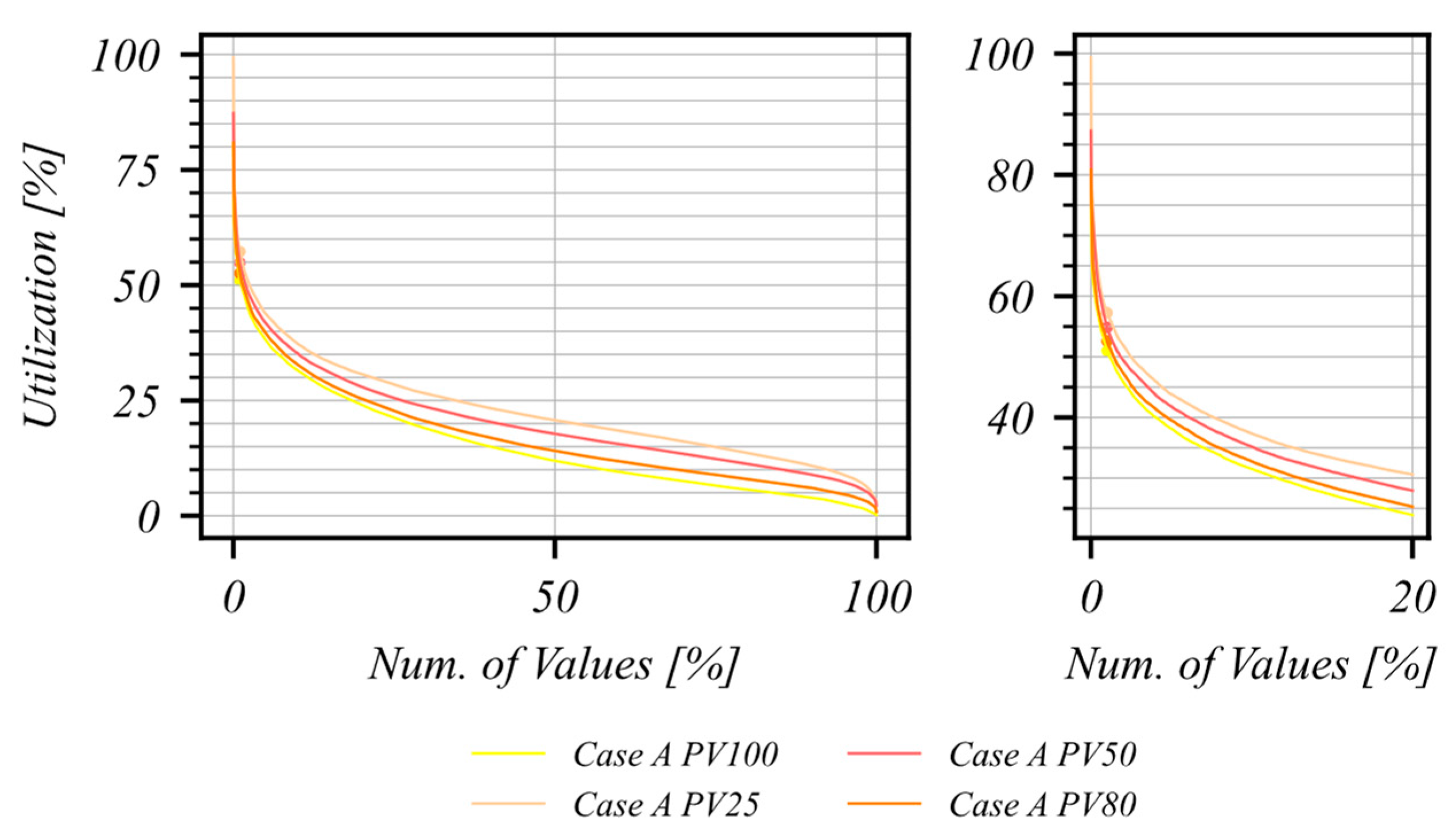
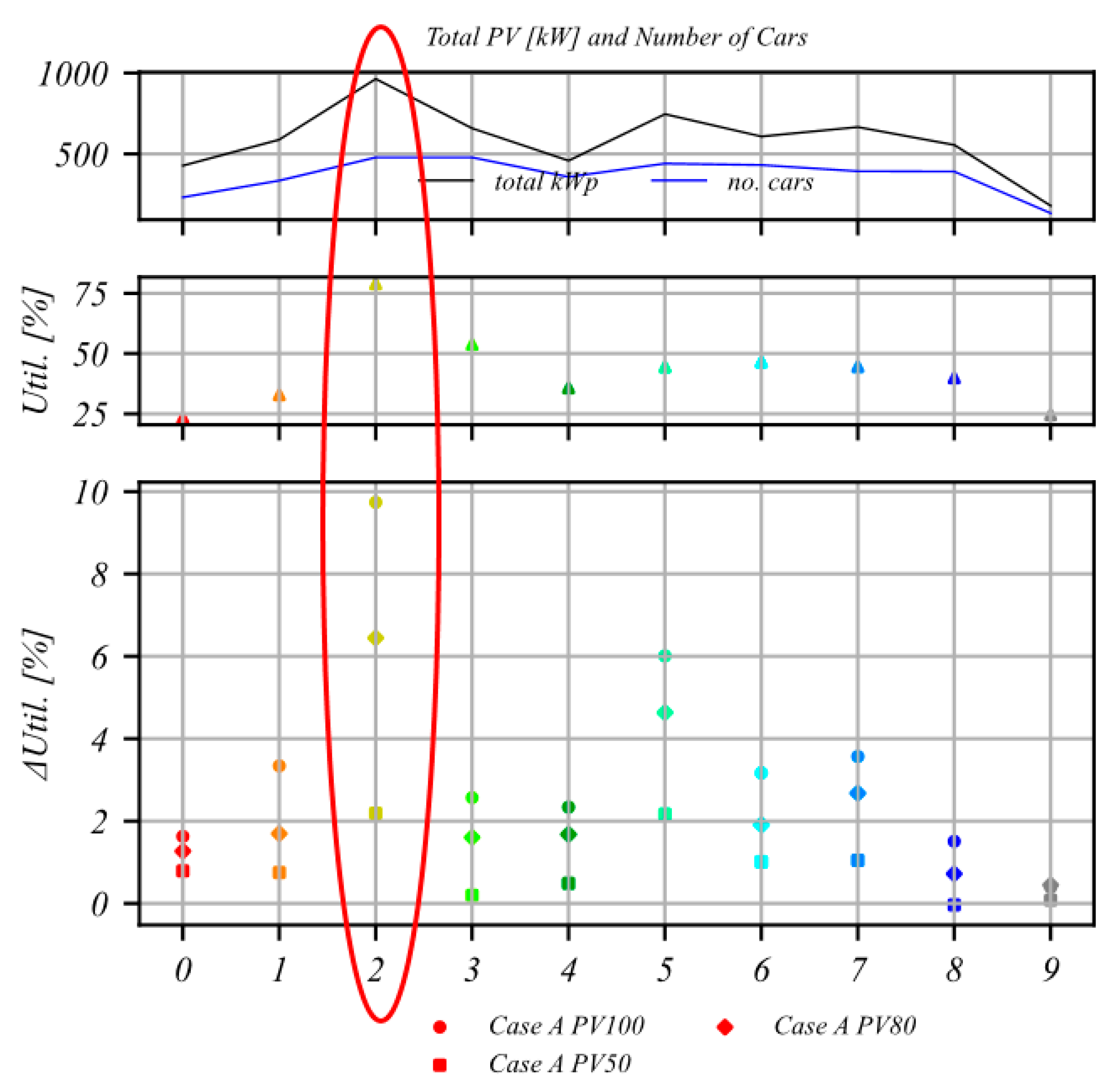


| Scenario | Charging Strategy | Market | Grid Fee | Mobility Behavior |
|---|---|---|---|---|
| Base Case | SoC independent | Flat Price | dynamic | random |
| Case A | maximize PV usage + SoC independent | Flat Price | dynamic | random |
| Case B | maximize PV usage + SoC independent | Spot Price | dynamic | random |
| Case C | maximize PV usage + SoC dependent | Spot Price | dynamic | random |
| CMin to CMax | Estimate | SE | p-Value |
|---|---|---|---|
| Intercept | 26.75 | 4.71 | 1.94 × 10−7 |
| m | 0.75 | 0.16 | 1.31 × 10−5 |
| CMin to CLimit − CMin | |||
| Intercept | 26.73 | 4.70 | 1.95 × 10−7 |
| m | −0.25 | 0.16 | 0.12 |
| CMax to CMax − CLimit | |||
| Intercept | −5.36 | 1.75 | 0.003 |
| m | 0.27 | 0.035 | 2.65 × 10−11 |
| Unit | Base Case | Case A | Case B | Case C | |
|---|---|---|---|---|---|
| Charging | |||||
| Grid | % | 98 | 71 | 71 | 69 |
| PV | % | 2 | 29 | 29 | 31 |
| Shifted | % | <0.3 | <0.1 | 4.9 | 38.9 |
| Pricing | |||||
| Average Cost | ct/kWh | 21.8 | 15.6 | 15.2 | 14.0 |
| Market | % | 78 | 79 | 72 | 73 |
| Grid | % | 22 | 21 | 28 | 27 |
| ø Grid Fee | ct/kWh | 4.3 | 3.9 | 3.4 | 3.0 |
| 95% quantile | ct/kWh | 6.4 | 5.8 | 7.4 | 6.6 |
| ø 95–100% | ct/kWh | 6.8 | 6.2 | 8.8 | 7.5 |
| Utilization | |||||
| ø Util. | % | 20 | 17 | 17 | 17 |
| 95%-quantile | % | 47 | 40 | 52 | 47 |
| ø 95–100% | % | 56 | 47 | 67 | 59 |
Disclaimer/Publisher’s Note: The statements, opinions and data contained in all publications are solely those of the individual author(s) and contributor(s) and not of MDPI and/or the editor(s). MDPI and/or the editor(s) disclaim responsibility for any injury to people or property resulting from any ideas, methods, instructions or products referred to in the content. |
© 2023 by the authors. Licensee MDPI, Basel, Switzerland. This article is an open access article distributed under the terms and conditions of the Creative Commons Attribution (CC BY) license (https://creativecommons.org/licenses/by/4.0/).
Share and Cite
Maurer, F.; Rieke, C.; Schemm, R.; Stollenwerk, D. Analysis of an Urban Grid with High Photovoltaic and e-Mobility Penetration. Energies 2023, 16, 3380. https://doi.org/10.3390/en16083380
Maurer F, Rieke C, Schemm R, Stollenwerk D. Analysis of an Urban Grid with High Photovoltaic and e-Mobility Penetration. Energies. 2023; 16(8):3380. https://doi.org/10.3390/en16083380
Chicago/Turabian StyleMaurer, Florian, Christian Rieke, Ralf Schemm, and Dominik Stollenwerk. 2023. "Analysis of an Urban Grid with High Photovoltaic and e-Mobility Penetration" Energies 16, no. 8: 3380. https://doi.org/10.3390/en16083380
APA StyleMaurer, F., Rieke, C., Schemm, R., & Stollenwerk, D. (2023). Analysis of an Urban Grid with High Photovoltaic and e-Mobility Penetration. Energies, 16(8), 3380. https://doi.org/10.3390/en16083380





